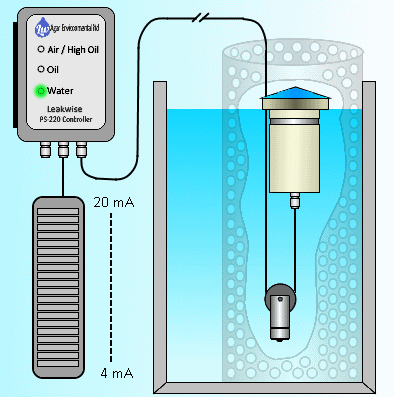Home » How it works
A Leakwise system consists of a sensor and a controller.
The sensor is a floating device that sits flat on water surface. It uses a patented Electromagnetic Energy Absorption Technique. The energy is introduced to the upper layer of the water.
Since water absorbs more electromagnetic energy than hydrocarbons, changes in the absorption rate of the water indicate the presence or buildup of a hydrocarbon layer.
The sensor continuously sends the measured signal to the controller, which in turn determines if there is a presence of hydrocarbon and indicates its’ thickness. The controller then activates your chosen alerts and controls according to easily adjustable sensitivity settings. Leakwise sensors can detect the presence of as little as 0.3 mm of hydrocarbon on water. Detection is immediate upon oil contact with the sensor, which fully complies with the 30 seconds requirement of FM Class 7745 standard. All Leakwise sensors can distinguish between water, hydrocarbon and no-liquid condition.
Some Leakwise sensors can be used to detect oil spills in applications where the sump area may be dry. Oil / Water emulsions will also be detected. Leakwise oil thickness sensors are optimized for linear measurement of thick oil layers on water up to 200 mm.
Leakwise controllers display system status on the front panel, and interface to user’s control center via relay contacts, 4-20mA, Modbus and wireless.
LEAKWISE sensors use a patented, high-frequency Electromagnetic Absorption Technique to detect oil on water. Each floating sensor houses a high-frequency electromagnetic energy transmitter and a receiving antenna which continuously monitor the liquid surface.
Since water absorbs more electromagnetic energy than hydrocarbons, changes in the absorption rate of water indicate the presence or buildup of hydrocarbons.
The LEAKWISE sensors not only enable reliable detection of hydrocarbons, but also provide valid indications of the thickness of the hydrocarbon layers and the percent of water in oily emulsions.
LEAKWISE sensors can also be used to detect the interface between any two immiscible liquids with different absorption rates. No other oil sheen monitoring system does this.

applications